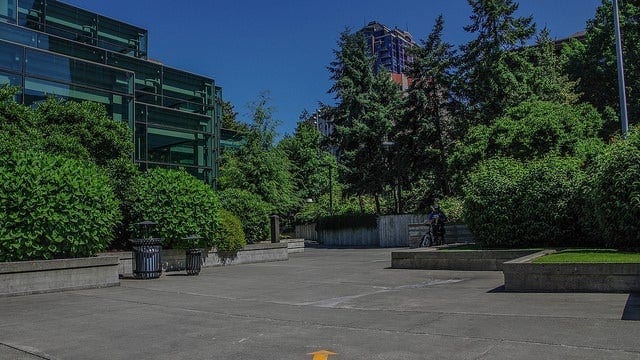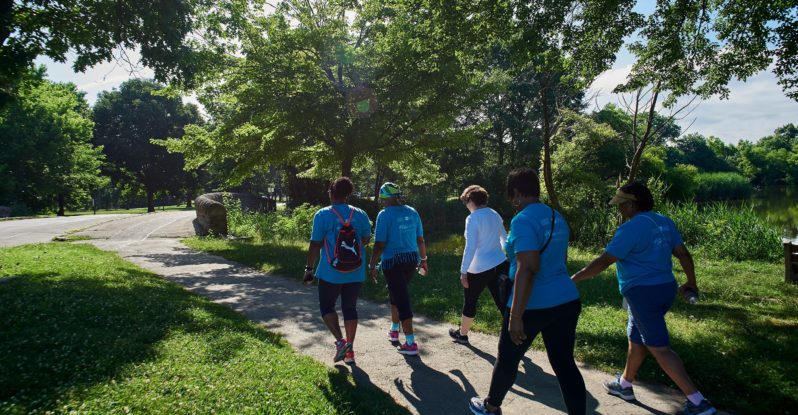
Photo copyright Freeway Park Association. This article was originally published on The Hill.
When it first opened in 1976, Seattle’s Freeway Park became America’s first park built over a highway – a ‘cap park’. Though it has been more than 40 years now, Freeway Park continues to serve Seattle well beyond its original design, to reconnect the Downtown and First Hill neighborhoods that were split by the construction of Interstate 5 and bring more nature to the heart of the city. The park celebrates urban infrastructure with large concrete structures, views of buildings and cars, and sounds of the city. And yet, the concrete, plantings, and water features not only evoke the mountains, forests and natural elements that surround the city, they also shield neighborhood residents and nearby convention center visitors from air pollution and divert stormwater from falling on the oil-slicked highway below. Additionally, the park has also spurred significant local investment, increased tourism and improved Seattle’s quality of life.
Freeway Park is not alone. Rose Fitzgerald Kennedy Greenway in Boston, Klyde Warren Park in Dallas, and City Arch River in St. Louis are more recent examples of parks connecting neighborhoods across the country. Emboldened by these models, other cities are pursuing new, more aggressive plans that use parks to solve modern challenges of growing populations, aging infrastructure, and changing climate conditions. In addition to providing outdoor recreation opportunities, city parks today are delivering a vast range of ecological services easily taken for granted, from storm and surface water management to carbon emissions reduction, keeping cities safer, cleaner and cooler.
In Washington, D.C. — with recent major storms and record flooding top-of-mind—legislators are once again talking about investing in our nation’s infrastructure. They use words like ‘resilience’ and ‘mitigation’ and highlight levees, dams, culverts and other efforts to address stormwater. It’s time to bring parks into the mix as we rebuild our urban infrastructure networks, to improve performance and make cities great places to live. A new video, “City Parks: America’s New Infrastructure,” from City Parks Alliance documents how Nashville, Atlanta, and Houston have invested in parks to mitigate flooding, improve public health, strengthen community cohesion, deliver transportation options, and attract private sector development to their urban cores. Parks are a smart investment with great environmental, social and economic returns.
However, city parks cannot be built, maintained or programmed and live up to their potential if they are not funded. And they cannot be funded if they are not part of the discussion when budget decisions are being made. Communities must include parks in their infrastructure proposals to attract the federal and state funding or other grant support necessary to build exceptional parks and lawmakers must also do their part in prioritizing parks in their decision-making.
Here, once again, Freeway Park is showing the way with its unique blend of collaborative funding that highlights how public dollars can be leveraged with civic support. The park was built and has been maintained with a broad mix of funding streams, including a county-wide bond measure and federal, state, county, city and private monies. None of this could happen without strong public leadership from Seattle Parks and Recreation and their partnership with the Freeway Park Association.
We have the proof of concept. Legislators can draw inspiration from Frederick Law Olmsted’s original 19th-century design for the Boston Park system, a string of nine continuous parks known as the Emerald Necklace, which has stood the test of time. Two centuries later, this cohesive infrastructure network is still meeting the same challenges that Boston faced then: providing relief from the pollution, noise, and overcrowding of city life, as well as dealing with the stormwater and flooding issues of the day.
It’s time to recognize the multiple benefits of parks and fund them as infrastructure if we want our cities to be successful and prepared for the future. As we consider how to meet our infrastructure needs at the federal and local levels, parks are an enduring and wise investment.
Catherine Nagel is executive director of City Parks Alliance, and Mami Hara is General Manager/CEO Seattle Public Utilities



